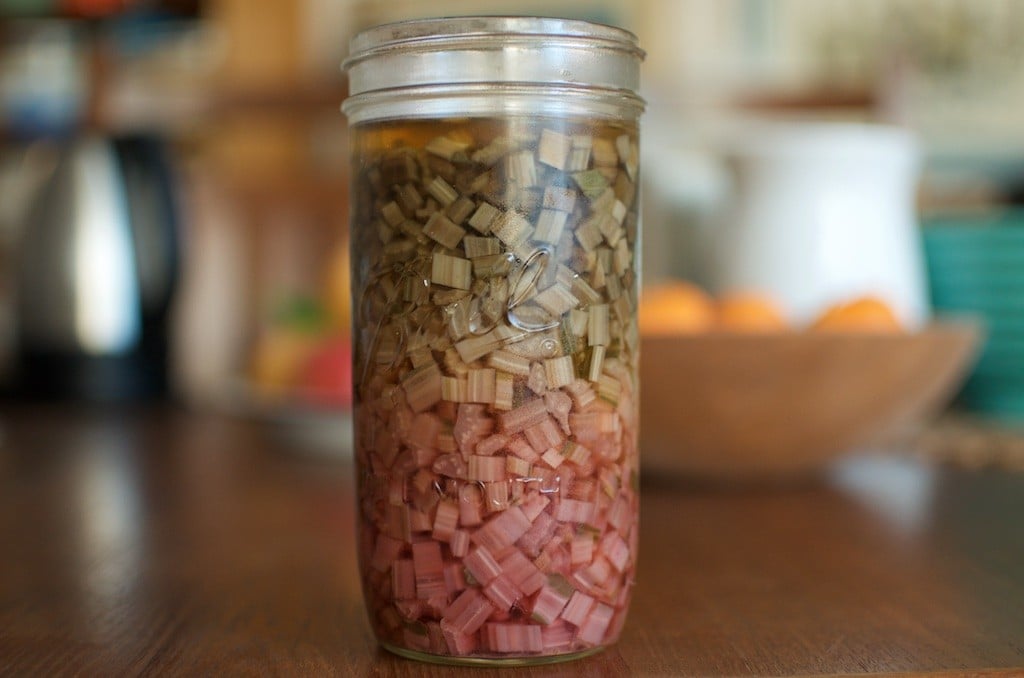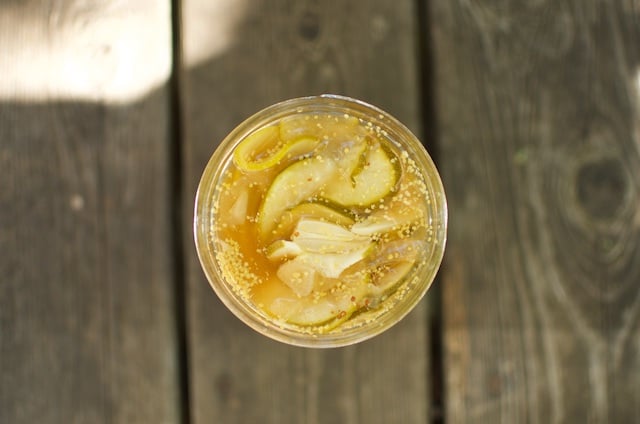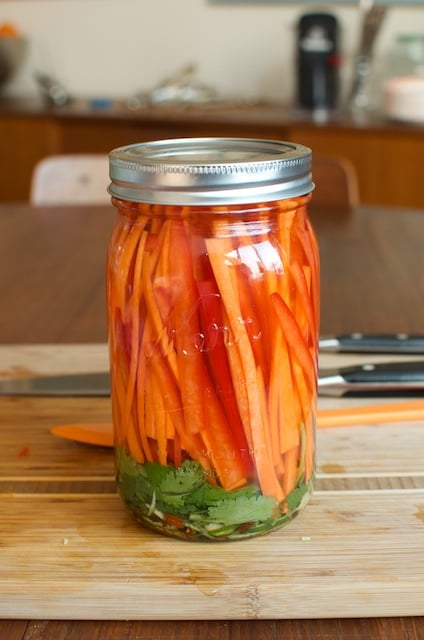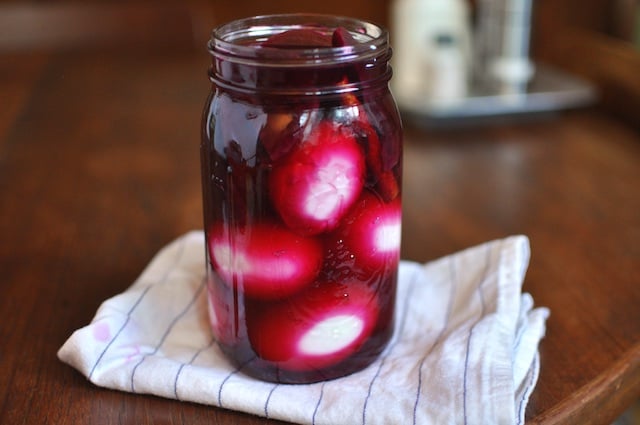Get your Mastery Challenge on with a batch of quick pickles!

Happy April, friends! This month, the Food in Jars Mastery Challenge is focusing on quick pickles. Also often known as refrigerator pickles, these pickles are typically made in small batches, involve a vinegar brine, need little time to age (often, they’re good to go in just a few hours), and spend the entirety of their lifetime in the fridge.
As in previous months, remember that the goal of this challenge is to help you expand your skills while creating something that you’ll actually use. So choose a project or recipe that will satisfy both your own learning and help you make something delicious.
Why a Quick Pickle?
While I like a preserved pickle as much as the next canner, there are a number of reasons why I often turn to small batches of quick pickles when I have produce that needs to be used up or kept from the compost pile.
They’re easy to make and you can make a batch as big or small as you want (years ago, I shared a small batch I’d made simply to keep a single English cucumber from going bad).
You can also be creative when you’re making a quick pickle. Because it’s not a going into a boiling water bath canner, you aren’t wedded to ratios of vinegar and water to ensure safety. You can reduce vinegar amounts and use lower acid vinegars like those made with rice wine (which are typically 4.2% vinegars rather than the 5% pickle-ready versions).
Quick pickles also have a firmer texture. If you’re someone for whom a pickle is judged on its snappy crunch, quick pickles are the way to go. Because they’re not exposed to the prolonged heat of a boiling water bath, they don’t soften nearly as much as a preserved pickle does.
What Should I Pickle Quickly?
The great thing about this style of pickling is that nearly every variety of fruit and vegetable is fair game. I often use this technique when I want pickled onions to heap on a burger, some tangy fruit to add to a grain salad, or a pickles to take to a potluck or cookout.
If you’re a fairly traditional pickle eater, consider starting with a basic batch of Garlic Dill Pickles. Snappy and bright, they’re one of my very favorite pickles. Another good option are thinly sliced carrots and radishes. I also turn to quick pickling when I want to use up odds and ends that might otherwise get trashed. The quick pickled chard stems at the end of this post are a good example of that kind of pickling. And while we’re not yet into the depths of zucchini season, keep this one tucked into the back of your mind when you’re swimming in zucchini.
On the fruity end of things, consider these pickled peaches. As written, it’s not a quick pickle recipe, but a quick version of those same peaches would have been sturdier and more textured. These pickled blueberries are much the same as the peaches.
And, a final one perfect for the Easter and Passover holidays coming soon. Pickled Red Beet Eggs!
And here are some suggestions from around the internet.
Quick Pickled Strawberries || Quick Pickled Red Onions || Quick Pickled Asparagus || Quick Pickled Carrot Spears || Quick Daikon and Carrot Pickle || Spicy Refrigerator Pickled Peppers || Quick Pickled Fennel with Orange || Quick Pickled Apple
To Blanch or Not to Blanch?
One of the nice things about making quick pickles is that they don’t require a lot of preparation. However, denser things like asparagus, carrots, green beans, and beets absorb pickle brine better after they’ve had 30-60 seconds in a pot of boiling water. It’s not absolutely required, but cuts down the amount of time they’ll need in order to take on the flavors you carefully tucked into your brine.
If you hate the idea of adding a blanching step, you can either skip it or slice and dice the vegetables into increasingly small bits. Just know that the finished pickles will need a few days longer in the fridge and that they’ll always retain an element of their raw texture.
Vinegars and Flavor Elements
Like I mentioned above, one of the best things about making quick pickles is that there’s so much space to be creative. You can use the wacky vinegars you picked up on vacation, or fill half the jar with fresh herbs to add flavor. My only word of advise is that less is often more when it comes to pickling. Don’t heap your entire herb garden into a single batch, hoping for greatness. Creative restraint is your friend.
How Long Can I Keep My Quick Pickles?
Provided that you took care to start with squeaky clean containers* and you have the available refrigerator space, quick pickles can last for months in the fridge. I once had a jar of quick pickled cucumbers that I kept for nearly a year and they were amazing when we finally unearthed the jar from the far reaches of the fridge.
However, if you’re opening and closing the jar on a regularly basis, they are best when eaten within four to six weeks of being made. After that they often soften and or develop mold. As always, the rule of thumb is that if you have any doubt about the safety of your pickles, throw them out.
*A great thing about quick pickling is that you can skip the traditional mason jars. Any vessel with a tightly fitting lid will do the job here (like the reused peanut butter jars pictured at the top of this post).
How Do I Use a Quick Pickle?
Quick pickles are great on sandwiches. They work beautifully chopped and tossed with a grain salad. I’m a big fan of adding them to potato salad. They brighten all manner of tuna salads and salmon cakes. Turn them into tartar sauce or Russian dressing.
What are you planning on making for this month’s quick pickle challenge?







If I’m not sure if my jars have been *perfectly* sanitized, how long should I expect my quick pickles to last in the fridge? Is a week safe? Longer? (Like you said, with opening and closing the jar often, they’ll last about a month. If my jar was *reasonably clean* but not “squeaky clean,” would it be about the same?)
I’ve had quick pickles last for many months. As long as they look good and smell good, they are good.
Strawberries are just coming into season here, so I may not be able to resist trying the quick pickled strawberry recipe! I’ve quick pickled vegetables before (red onion is a favorite for sandwiches and salads) but never tried fruit. It sounds magical!
I am anxious to try the pickled carrot and the traditional cuke pickle. Still don’t know what to do with the Blackberry Shrub I made, glad it wasn’t an expensive or time consuming project. This one is more “useable” for me.
If you’re struggling to use your shrub, try making salad dressing out of it. I do half olive oil, half shrub, a pinch of salt, and a few turns of a pepper grinder. It makes a tasty, fruit-forward vinaigrette.
I’ve already make pickled cukes and will make another batch soon. I’m also due for some pickled red onions. I’ll definitely be trying pickled strawberries come strawberry season!
I’m not a big pickle fan, except for very garlicky kosher pickles. But recently, I’ve been going to a monthly lunchtime meeting where deli sandwiches are served, along with cole slaw and a bowl of pickles. There are some very crunchy, lightly pickled small cukes – probably only 3-4″ long, maybe 3/4″ to 1″ diameter. I’d like to try to duplicate these if I can. May need to pick up some extra garlic this month!
My dad didn’t eat a lettuce salad. Thus, I would “play” with his cottage cheese and veggies to make his salad reflect the day, especially on holidays. He rarely commented as he didn’t really approve of playing with food in any way. But I did get a wry smile from him when I played with some beet pickled eggs. I cut the egg in half then cut one half in half again. That half became the bunny ears and the other half the bunny. I used black olive bits for eyeballs and julienned carrots for whiskers. I miss my dad.
I have enjoyed the challenges but I am moving in 3 weeks and may pass at the moment. I have quick pickled by reusing pickling juices in an empty jar (no slices left) to quick pickle cucumbers, radishes, onions and even the chard stems. Alas, the chard stems were tough, and I like the tip to blanch them. Have given the recipe to a friend who would never make a big batch of processed pickles. Have tried pickling cherry tomatoes sweet by piercing with a toothpick first, not too good and my DIL makes a strong dill and garlic,bay leaf cherry tomato pickle.
I am going to pass this month. I really don’t like anything pickled. I hate actual pickles of any kind, kosher, deli, sweet, doesn’t matter. Can’t stand sauerkraut either. The only thing I eat that is brined is pimento stuffed green olives and I’ll assume we’re not making any of those. Even if we were, I can buy them easier than I can make them.
So I’ll pass. Not even going to pickle any fruit. I’d rather make a jam with fruit than brine it. I’m more likely to use a shrub than a pickled fruit.
Fair enough! Not every preserve is for every person!
My artichoke plant is putting out buds and Passover isn’t for a week, so I’m going to marinate the hearts for the Seder salad. You do have to cook the hearts first, but it isn’t a fermented pickle and does keep in the fridge for a couple of weeks.